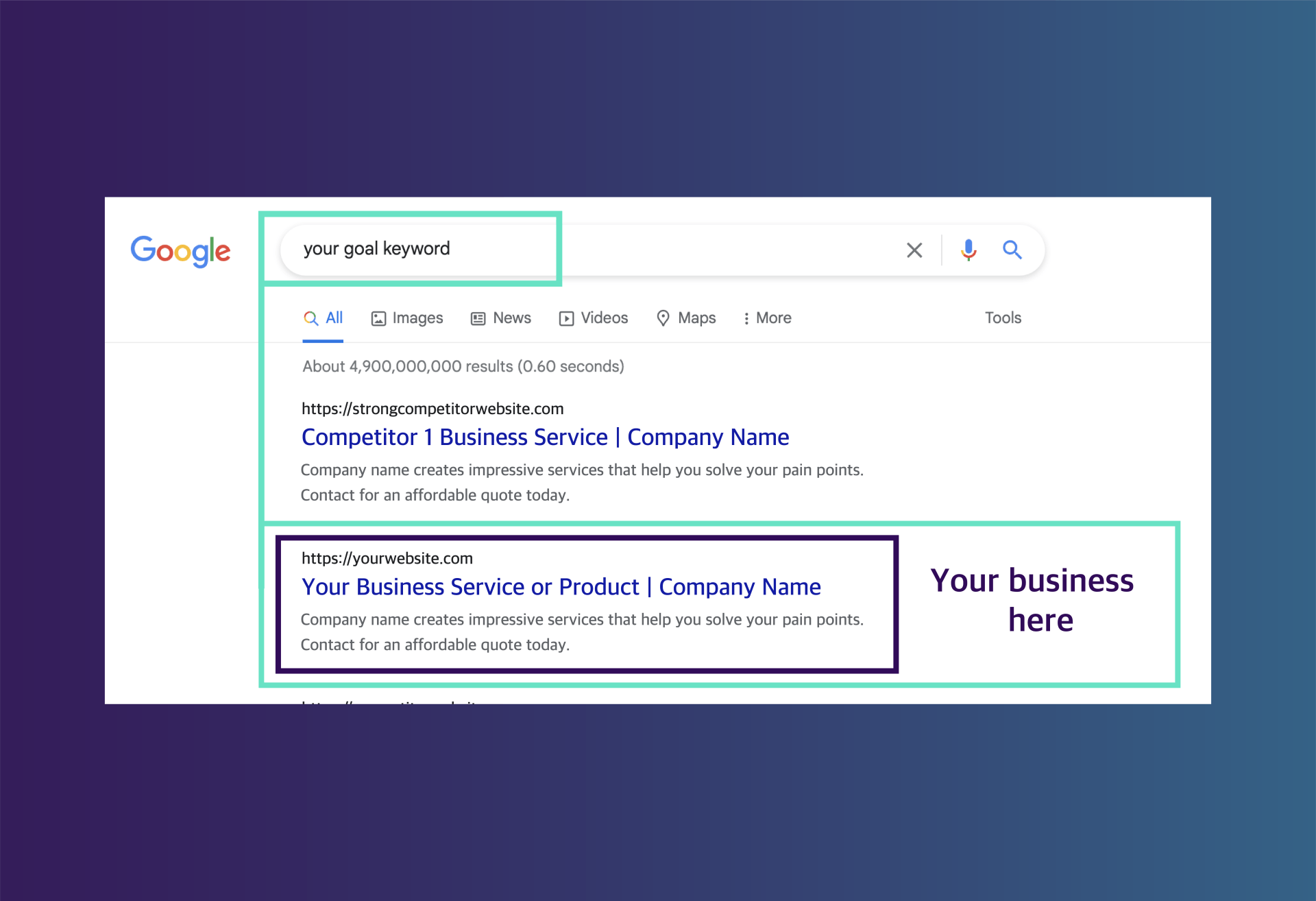What is SEO and Why Doesn't My Website Show in Google Search?
Search Engine Optimization (SEO) is the process of making updates to your website that can bring in thousands of new visitors that become customers.
What is SEO?
In order to show up on the first page of search engine results, such as Google, you need to know how to optimize every page using SEO best practices for keyword strategy, content, and UX design. The goal of these website updates is to create high quality content that aligns with a relevant keyword and useful information that address the pain points of your potential customers. Learn more about these three key SEO elements in more detail below.
-
Keyword Strategy
Every page needs to target a relevant and high volume keyword that a potential customer would type in Google search results. We use research tools and experience to set the best possible possible keyword targets for our client's pages.
-
Content Quality
Website content must have clear information that a reader would find useful, supports the target keyword and topic, and also incorporate engaging custom images that add helpful context for the website visitor.
-
UX Design
The Google algorithm incorporates real user interaction data annd website pagespeed to assess whether the page is providing a good user experience (UX). This means that you need to follow all UX design best practices to engage the website visitor.
Why Doesn't My Website Show Up in Google Search?
In my experience with hundreds of website audits, there are four main reasons why a website page does not show up in Google search results.
1. Technical SEO Errors
One reason that a page may not be showing up in search results is that there are technical issues such as the page having a 'noindex' tag, the page is an orphan page that isn't included in the Google Search Console sitemap or linked from another page, the website has no backlinks, or the page has remarkably slow pagespeed.
- Tech SEO Solutions: These issues are most easily diagnosed using free tools to scan your website such as Google Search Console or paid tools such as Ahrefs and SEMrush. If relevant, you can also connect your website pages to Google My Business, Google Merchant, and Google Events to expand your options for showing up in Google search.
2. Competition
Another common reason that a page may not be reaching first page search results is that the target keyword is too competitive for their website's current level of backlinks and topical authority. For example, a brand new website with only 5 pages and one backlink will not be able to rank above the competition for a keyword such as "financial advise." The competition for this keyword are international financial firms and news outlets such as Forbes magazine, which have hundreds more high quality backlinks to thoughtful resource pages.
- Competition Solutions: The best way to avoid this error is to use keyword research tools to help pick long-tail keyword phrases that your website can rank for and optimize your page for results in specific locations if you are a local business. For example, the "financial advise" target may instead focus on a more niche keyword and topic such as "How much does a financial advisor cost in Texas?" You may also need to earn more backlinks for your website and specific pages to rank in competitive search results.
3. Content Quality Issues
If the website page has a good keyword target but still isn't showing up in results, then the most common issue is that the content on the page is not providing the right kind of useful information that both users and Google would expect to see covered for the topic.
- Quality Solutions: In order to avoid this issue, you need to focus on two elements of content creation: target audience and topic research. You can consider interviewing subject matter experts if you don't feel you can provide all the relevant information your audience would need to find the content useful.
4. Keyword and Content Do Not Align.
Finally, another common reason why a website's content may not be ranking is when the content does not support the target keyword. For example, a page won't rank if their goal keyword is "window cleaning services" but the page only lists types of windows without addressing essential questions about services such as locations, hours, and rates.
- Alignment Solutions: The best way to improve keyword and content alignment is to focus on improving search intent. Search intent is the reason "why" a user will type in the target keyword and the content needs to answer the search intent seamlessly. If you are new to this concept, I recommend reading the Ahref blog's thorough review of search intent to learn more.
Additional SEO Resources
If you would like to learn more extensive tips and tricks that will help your website rank on first page search results, I recommend checking out the blogs below:
- Ahrefs Blog *My top pick!
- Search Engine Round Table
- Moz Blog
By implementing SEO strategies on my scientific illustration website, I was able to increase my annual website leads by 91% and my monthly organic website visitors went up from 200 new users a month to over 5,000 new users a month.
Global SEO Campaign to Increase Leads and Traffic
Karen Thiebes, Founder of Simplified Science Publishing
USEFUL LINKS
FREE CONSULTATION
You need a helping hand with your project?
Thank you for requesting a free SEO consultation!
We will get back to you with potential meeting times as soon as possible.
Please try again later
All Rights Reserved | Simplified Science Publishing, LLC



